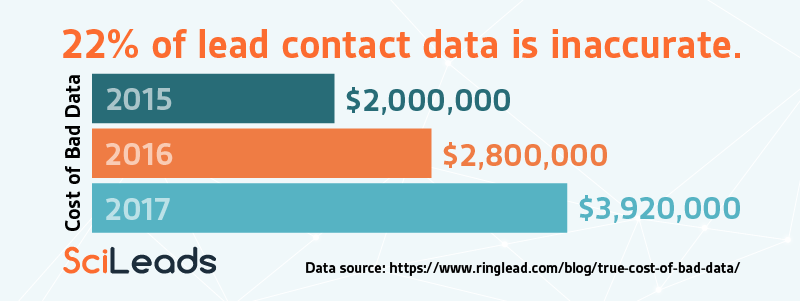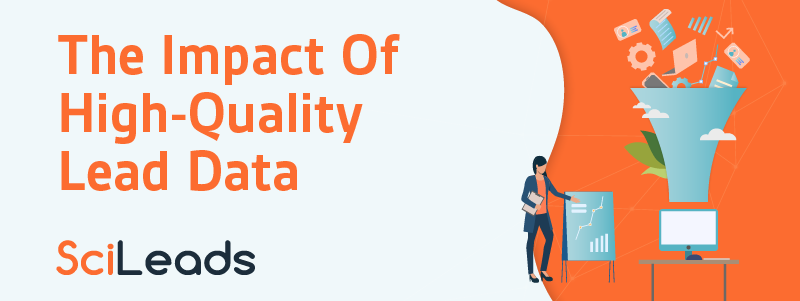Sales success is directly affected by the quality of your leads. This is particularly true in life sciences, where sales cycles are often long and complex and it’s important to continually nurse your pipeline. Here the key is to keep your lead data accurate and reliable in order to communicate in a relevant and timely manner that enhances your reputation and standing.
Customer contact data becomes outdated, or decays, at a minimum of 30% per year. In B2B sales and in fields with a high job turnover, this number is estimated as high as 70.3%.
What’s worse, the life sciences already have an especially low lead-to-customer conversion rate. This is because the vast number of prospects and leads entering the sales funnel are often poorly or incompletely qualified, the market isn’t well understood, and the conversion funnel isn’t well planned. This causes marketing to work overtime while their sales enabling efforts idle.
When left unattended, accumulating data decay leads more and more data driven marketing astray. Data decay costs an estimated 12% of annual revenue in nearly all companies. A reported 28% of companies experience suffered customer service as a result, while 21% see reputational damage as unrelated marketing mail, confounding follow-ups and customization catastrophes enter a prospect’s inbox.

What causes contact data decay in the life sciences?
1. Changing Location
A growing number of life science researchers are becoming mobile. It’s easier and even encouraged for researchers to change institutions, departments, laboratory units, and to relocate all together, temporarily or permanently. Scientists with more publications and NIH funding are more likely to change location, and the higher the degree, the higher the likelihood of moving.
What’s more, researchers may have multiple affiliations with universities or research institutions and keeping track of them all becomes even more complex as researchers relocate
2. Email Variability
Using the correct email address is critical for successful outreach. 67% of organizations report problems in delivering prospect emails, with incorrect address data hurting subscription and loyalty programs over time.
Life scientists often contain multiple work emails, each with different domains and email variations. This variance can impact the deliverability of sales & marketing outreach.
3. Job Titles
Together with relocating, life scientists’ progress in their careers creates an uncertainty in their current professional stage.
A change in title can make the difference between a highly qualified or a disqualified lead. Those identified as PhD candidates last year may now have jumped into a lab leader or other buying decision making roles.
4. Research Focus
Similarly, life scientists’ research themes are in continuous flux due to the rapidly modernizing field.
Increasingly specialized research areas like systems and synthetic biology, bioinformatics, protein engineering and automation make it harder to categorize scientists under one topic. The keywords from these emerging fields determine whether a scientist’s needs are relevant to a specific market.
5. Grants
New life science funding means new potential customers. Grants are awarded continuously in the life sciences, yet these don’t always appear in frontline news and can be laborious to systematically follow in the media. Lack of awareness around life science grants and funding can result in losing the cutting edge when it comes to new business.

What value will high-quality data bring to your business?
Maintain high lead quality & sales performance
Periodically updating CRM contacts will keep your life sciences lead data accurate, so that marketing can be tailored and targeted to high-quality B2B lead generation and protect your lead-to-customer conversion rate.
Optimise the time to sell
Knowing when to sell is just as critical as knowing who to sell to. Having the latest accurate data makes nurturing leads in the life sciences easier.
Improve relevant messaging
High-quality data allows an unmatched degree of personalization and relevance to target leads. This increases responses and conversion and leads to more, higher quality discussions, reflecting well on customer service and avoids losing important life science prospects.
Increase deliverability
Accurate data will allow your outreach efforts to reach their intended contacts, maximize exposure and guarantee that sales follow-up emails and never miss their target.
Discover more potential leads
Being aware of newly allocated research funding allows you to stay up to date on the latest developments in the field. It helps find fresh business opportunities and leads so you can respond first to offer relevant products and services.
Having a lead data strategy is the solution for safeguarding data-driven life sciences marketing and sales. Although a systematic problem, data decay can be tackled with standardized, automated data maintenance.
The SciLeads platform is constantly updated with new leads as well as updated information on research grants, publications, and event attendance. The data is consistently checked to ensure that it is accurate so that leads aren’t lost through incorrect email addresses or out of date job roles. Plus, with our latest list features, alerts can be set up when new funding is allocated to a prospect to allow for more timely and relevant conversations. Find out more and experience the platform for yourself here.


